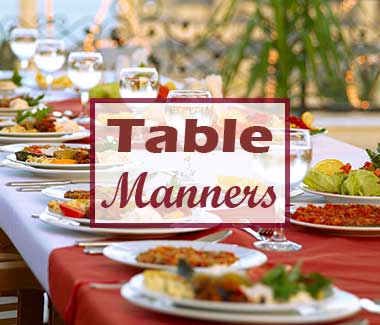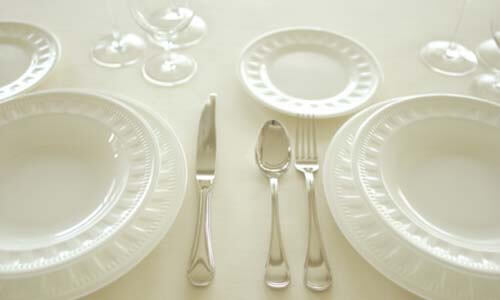Forks
Table Setting Guide
A set of flatware typically contains five forks:
- Dinner Fork;
- Fish Fork;
- Luncheon Fork;
- Salad Fork or Dessert Fork; and
- Seafood Fork.
In addition, there are an array of specialized forks:
- Lobster Fork;
- Fruit Fork;
- Ice-Cream Fork;
- Pastry Fork;
- Strawberry Fork;
- Snail Fork; and
- Oyster Fork.
The shapes of the fork tines accommodate particular foods.
Although flatware is made in continental and American lengths, the American size, also called place size, is the most popular dimension.
THE DINNER FORK
The dinner fork measures about 7 inches in length. It is used to eat the main course at all formal and informal meals. The continental-size dinner fork is slightly larger than the American-size dinner fork. It is used for the most formal events. The American-size dinner fork, or place size, is approximately ½ inch shorter than continental size and is used in the informal table setting.
FISH FORK
The fish fork is approximately 7¼ to 7¾ inches in length and is used in formal and informal dining. To provide leverage in separating fish from the body, the fish fork features an extra wide left tine, and an optional notch, grooved to fit over the bones.
LUNCHEON FORK
The luncheon fork is approximately 6¾ inches long, a size in proportion with a luncheon plate, and found more often in older sets of flatware.
LOBSTER FORK
The lobster fork is approximately 6¾ to 8 inches long. It is made with one long narrow tine that ends with two hooks or with a long, narrow center tine and two hooked tines on either side; both shapes are used to spear lobster served in a shell. Because the lobster shell is steadied in the hand and the lobster fork is held in the other hand, the utensil is used only in informal dining.
FRUIT FORK
The fruit fork is made with narrow tines and a long slender handle; it is approximately 6¼ inches in overall length. Although the fruit fork is used in formal and informal dining, Americans tend to eat cut fruit with fingers, and the fruit fork is used more often in Europe.
SALAD FORK
The tines of salad forks are flatter and slightly broader than those of a dinner fork, and the utensil is approximately 6 inches long. To provide leverage when cutting thick veins of lettuce or broad vegetables, the salad fork is made with an extra wide left tine that is sometimes grooved. For additional strength, the second and third tines of the salad fork are occasionally connected by a rod. The salad fork is used in formal and informal dining. It is also used for appetizer courses other than seafood, such as pate.
DESSERT FORK
The dessert fork is a specialized fork approximately 6 to 7 inches in length, that looks similar to a salad fork, only a little narrower. It is not made as part of a flatware set. The left tine is extra wide to provide leverage in cutting firm dessert, such as baklava. The dessert fork is used in formal and informal dining.
ICE-CREAM FORK
The icecream fork features a wide shallow bowl with three tines at the tip. The spoon part is used to scoop and eat soft ice cream, and the tines to cut, spear, and lift firm bites to the mouth.
PASTRY FORK
The pastry fork looks similar to a salad fork, but it is narrower and slightly shorter, approximately 5 to 5½ inches long. To provide leverage in cutting, the left tine is often notched. The pastry fork is used in informal dining, although it is not essential; it is not used in formal dining where two dessert utensils are presented.
SEAFOOD FORK
The seafood fork, also known as a cocktail fork; is a small, narrow, three-pronged fork made with short tines and a long handle; it is approximately 4½ to 5½ inches in length. The purpose of a seafood fork is to spear seafood.
The seafood fork is used in formal and informal dining. At a multi-course formal dinner or luncheon, the seafood fork is the fourth fork laid on the table. It is placed to the right of the oval soup spoon. Sometimes the tines of the seafood fork rest in the bowl of the soup spoon and the handle is angled to the right. At an informal meal, the seafood fork is used as needed.
STRAWBERRY FORK
The strawberry fork is made with three long narrow tines and is approximately 4¾ to 5¾ inches long.
The strawberry fork is used to pierce fresh strawberries and dip them into condiments, such as powdered sugar, brown sugar, whipped cream, and sour cream.
SNAIL FORK
The snail fork is approximately 4½ inches in length with two long, pointed tines. In formal dining, snails are prepared without shells and served on a snail dish made with indentations to hold the buttery sauce and the meat is eaten with a snail fork. In informal dining, snails are usually served in shells. The diner steadies the shell with metal tongs or a napkin-covered hand, and extracts the meat with a snail fork held in the other hand.
OYSTER FORK
The oyster fork is a small utensil made with three short wide curved tines, approximately 4 inches in length. The left tine is extra wide to assist in cutting the membrane that connects the oyster to the shell. The oyster fork is used only in informal dining. The shell is steadied with the fingers of one hand and the utensil is held in the other hand to extract the meat.



